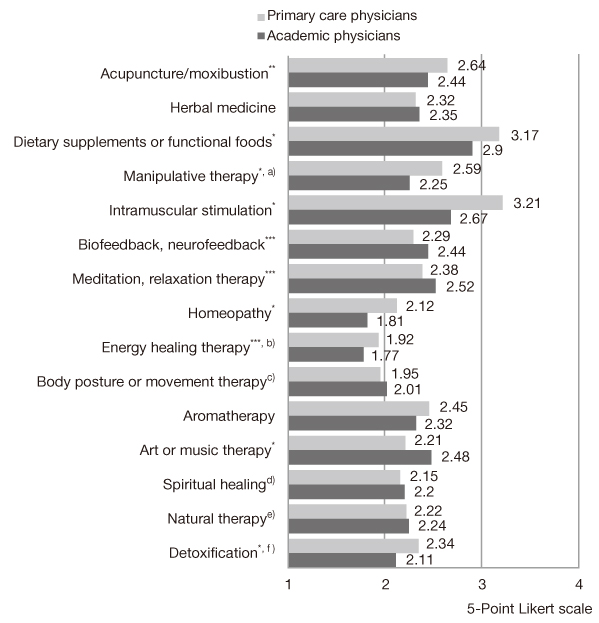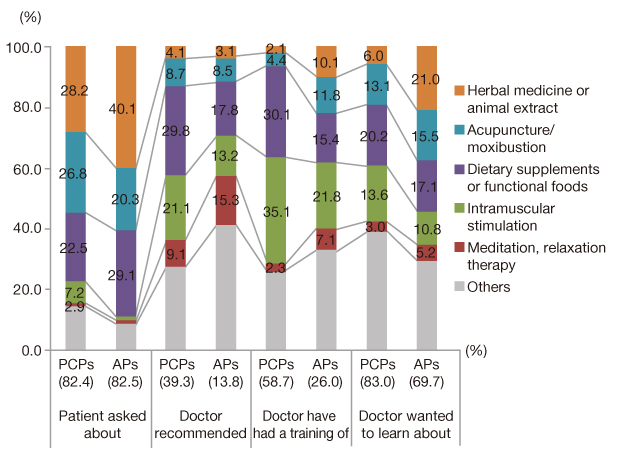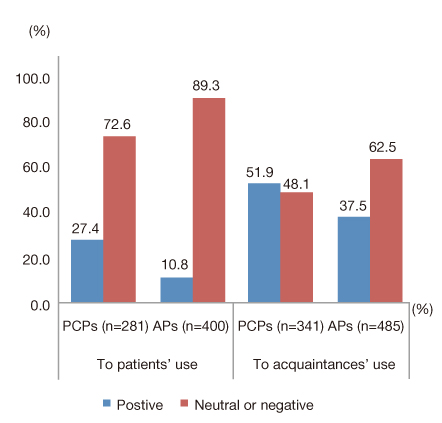J Korean Med Assoc.
2011 Feb;54(2):217-229. 10.5124/jkma.2011.54.2.217.
Comparison of knowledge, attitude, and experience about complementary and alternative medicine between primary care physicians and academic physicians in Korea
- Affiliations
-
- 1Institute of Complementary and Integrative Medicine, Medical Research Center, Seoul National University, Seoul, Korea. drdemian@snu.ac.kr
- 2Department of Health Science and Services, Seoul National University Graduate School of Public Health, Seoul, Korea.
- 3Department of Medicine, Seoul National University College of Medicine, Seoul, Korea.
- 4Medical Research Collaborating Center, Seoul National University Hospital, Seoul, Korea.
- KMID: 2189145
- DOI: http://doi.org/10.5124/jkma.2011.54.2.217
Abstract
- Despite the recent increase in the use of complementary and alternative medicine (CAM) among the general population and patients, little is known about Korean physicians' attitudes about and interest in CAM. We conducted a web-based survey of knowledge, attitude, and experience in CAM among primary care physicians (PCPs) and academic physicians (APs) in Korea. A total of 826 physicians (341 PCPs and 485 APs) responded. Respondents in both groups felt that they were not sufficiently knowledgeable about CAM. PCPs, however, had a significantly higher composite index score in CAM knowledge than that of APs. Although APs were more skeptical about the scientific evidence of CAM than PCPs, both groups had a positive attitude toward CAM. The level of experience in utilizing CAM in their practice was 23.2% among PCPs, which was much higher than that among APs (2.7%). Experience rates of referring patients to CAM were 11.7% in PCPs and 4.5% in APs (P<0.001). Despite the discrepant rates in CAM education between the two groups (58.7% in PCPs and 26.0% in APs, P<0.001), the majority of doctors in both groups (85.0% in PCPs and 70.0% in APs) expressed an intention to participate in authorized CAM coursework. In conclusion, despite the lack of scientific evidence, both PCPs and APs have an interest in incorporating CAM into their conventional medical practices. To meet physicians' increasing needs for CAM the Korean medical societies should promote education and research about CAM in the conventional medical system.
MeSH Terms
Figure
Reference
-
1. Barnes PM, Powell-Griner E, McFann K, Nahin RL. Complementary and alternative medicine use among adults: United States, 2002. Adv Data. 2004. (343):1–19.
Article2. Barnes PM, Bloom B, Nahin RL. Complementary and alternative medicine use among adults and children: United States, 2007. Natl Health Stat Report. 2008. (12):1–23.
Article3. Xue CC, Zhang AL, Lin V, Da Costa C, Story DF. Complementary and alternative medicine use in Australia: a national population-based survey. J Altern Complement Med. 2007. 13:643–650.
Article4. Härtel U, Volger E. Use and acceptance of classical natural and alternative medicine in Germany: findings of a representative population-based survey. Forsch Komplementarmed Klass Naturheilkd. 2004. 11:327–334.
Article5. Saydah SH, Eberhardt MS. Use of complementary and alternative medicine among adults with chronic diseases: United States 2002. J Altern Complement Med. 2006. 12:805–812.
Article6. Artus M, Croft P, Lewis M. The use of CAM and conventional treatments among primary care consulters with chronic musculoskeletal pain. BMC Fam Pract. 2007. 8:26.
Article7. Corner J, Yardley J, Maher EJ, Roffe L, Young T, Maslin-Prothero S, Gwilliam C, Haviland J, Lewith G. Patterns of complementary and alternative medicine use among patients undergoing cancer treatment. Eur J Cancer Care (Engl). 2009. 18:271–279.
Article8. Astin JA, Marie A, Pelletier KR, Hansen E, Haskell WL. A review of the incorporation of complementary and alternative medicine by mainstream physicians. Arch Intern Med. 1998. 158:2303–2310.
Article9. Hsiao AF, Ryan GW, Hays RD, Coulter ID, Andersen RM, Wenger NS. Variations in provider conceptions of integrative medicine. Soc Sci Med. 2006. 62:2973–2987.
Article10. Lee SI, Khang YH, Lee MS, Koo HJ, Kang W, Hong CD. Complementary and alternative medicine use in Korea: prevalence, pattern of use, and out-of-pocket expenditures. Korean J Prev Med. 1999. 32:546–555.11. Ock SM, Choi JY, Cha YS, Lee J, Chun MS, Huh CH, Lee SY, Lee SJ. The use of complementary and alternative medicine in a general population in South Korea: results from a national survey in 2006. J Korean Med Sci. 2009. 24:1–6.
Article12. Lee SI, Khang YH, Lee MS, Kang W. Knowledge of, attitudes toward, and experience of complementary and alternative medicine in western medicine-and oriental medicine-trained physicians in Korea. Am J Public Health. 2002. 92:1994–2000.
Article13. Hong CD. Complementary and alternative medicine in Korea: current status and future prospects. J Altern Complement Med. 2001. 7 Suppl 1:S33–S40.
Article14. Perkin MR, Pearcy RM, Fraser JS. A comparison of the attitudes shown by general practitioners, hospital doctors and medical students towards alternative medicine. J R Soc Med. 1994. 87:523–525.15. National Health Insurance Corporation, Health Insurance Review & Assessment Service. 2008 National Health Insurance statistics. 2009. Seoul: National Health Insurance Corporation, Health Insurance Review & Assessment Service.16. Lewith GT, Hyland M, Gray SF. Attitudes to and use of complementary medicine among physicians in the United Kingdom. Complement Ther Med. 2001. 9:167–172.
Article17. Hyland ME, Lewith GT, Westoby C. Developing a measure of attitudes: the holistic complementary and alternative medicine questionnaire. Complement Ther Med. 2003. 11:33–38.
Article18. Schneider CD, Meek PM, Bell IR. Development and validation of IMAQ: Integrative Medicine Attitude Questionnaire. BMC Med Educ. 2003. 3:5.
Article19. Furnham A, McGill C. Medical students attitudes' about complementary and alternative medicine. J Altern Complement Med. 2003. 9:275–284.
Article20. Rosenbaum ME, Nisly NL, Ferguson KJ, Kligman EW. Academic physicians and complementary and alternative medicine: an institutional survey. Am J Med Qual. 2002. 17:3–9.
Article21. Berman BM, Singh BB, Hartnoll SM, Singh BK, Reilly D. Primary care physicians and complementary-alternative medicine: training, attitudes, and practice patterns. J Am Board Fam Pract. 1998. 11:272–281.
Article22. Stange R, Amhof R, Moebus S. Complementary and alternative medicine: attitudes and patterns of use by German physicians in a national survey. J Altern Complement Med. 2008. 14:1255–1261.
Article23. Maha N, Shaw A. Academic doctors' views of complementary and alternative medicine (CAM) and its role within the NHS: an exploratory qualitative study. BMC Complement Altern Med. 2007. 7:17.
Article24. van Haselen RA, Reiber U, Nickel I, Jakob A, Fisher PA. Providing complementary and alternative medicine in primary care: the primary care workers' perspective. Complement Ther Med. 2004. 12:6–16.
Article25. Song MY, John M, Dobs AS. Clinicians' attitudes and usage of complementary and alternative integrative medicine: a survey at the Johns Hopkins Medical Institute. J Altern Complement Med. 2007. 13:305–306.
Article26. Joos S, Musselmann B, Szecsenyi J. Integration of complementary and alternative medicine into family practices in Germany: results of a national survey. Evid Based Complement Alternat Med. 2011. 2011:495813. DOI: 10.1093/ecam/nep019.
Article27. Burg MA, Kosch SG, Neims AH, Stoller EP. Personal use of alternative medicine therapies by health science center faculty. JAMA. 1998. 280:1563.
Article28. Milden SP, Stokols D. Physicians' attitudes and practices regarding complementary and alternative medicine. Behav Med. 2004. 30:73–82.
Article29. Levine SM, Weber-Levine ML, Mayberry RM. Complementary and alternative medical practices: training, experience, and attitudes of a primary care medical school faculty. J Am Board Fam Pract. 2003. 16:318–326.
Article30. Corbin Winslow L, Shapiro H. Physicians want education about complementary and alternative medicine to enhance communication with their patients. Arch Intern Med. 2002. 162:1176–1181.
Article31. Ock SM, Kim CM, Choi WS, Ju SY, Shin HC, Song CH. Perception and experience of CAM education for family practice residents by family practice training faculty in South Korea. J Korean Acad Fam Med. 2008. 29:932–938.
- Full Text Links
- Actions
-
Cited
- CITED
-
- Close
- Share
- Similar articles
-
- A Comparative Study of Nurses and Physicians' Attitudes about Complementary and Alternative Therapy
- The attitude and behavior if primary physicians in seoul toward alternative medicine
- Knowledge and Attitude about Alternative Treatment in Cancer Patient
- Nurses versus physicians' knowledge, attitude, and performance on care for the family members of dying patients
- Family Physician's Knowledge, Attitude, Experience and Training on Breastfeeding




